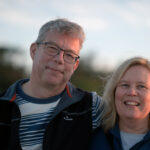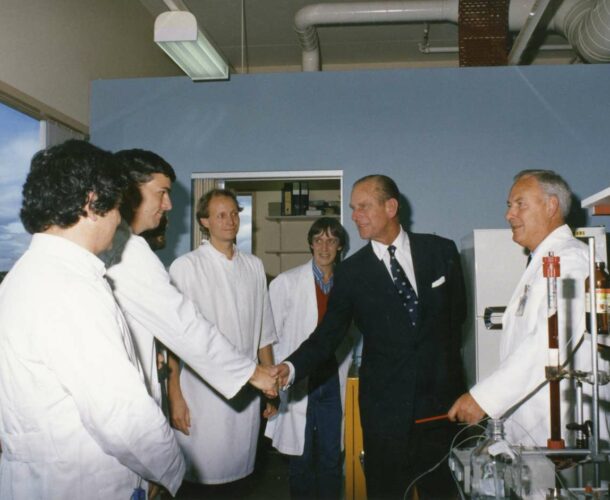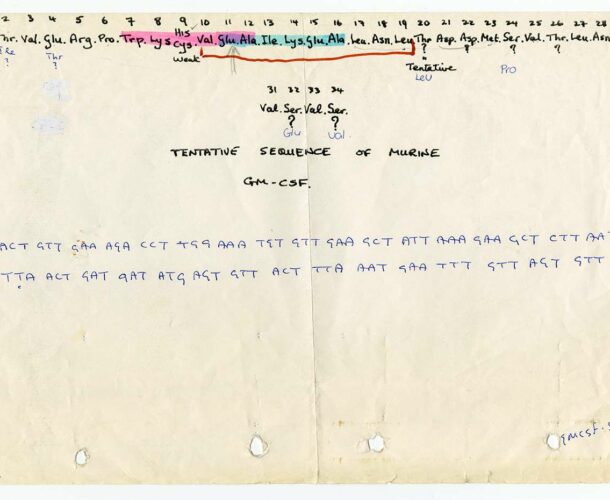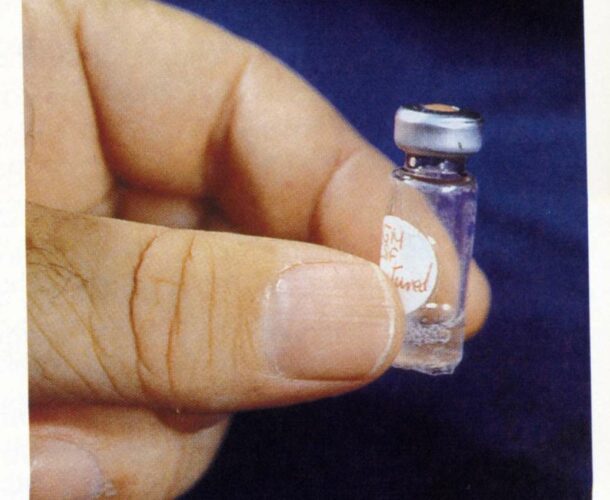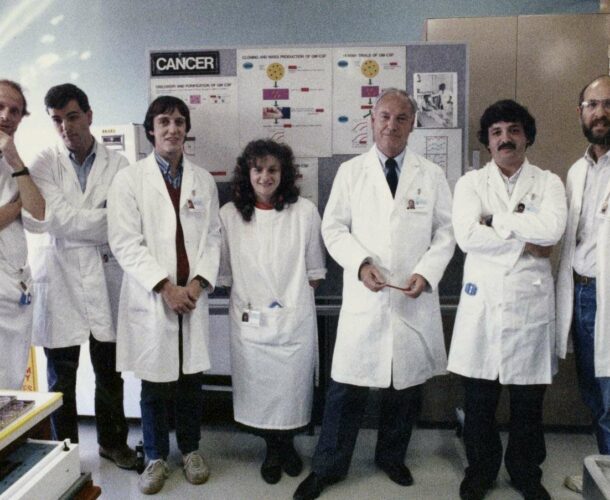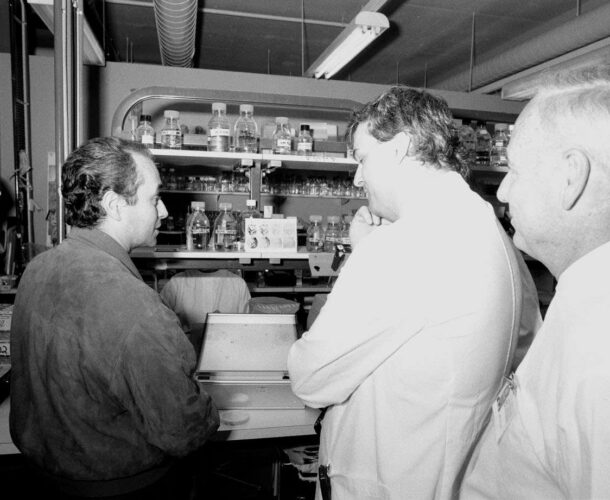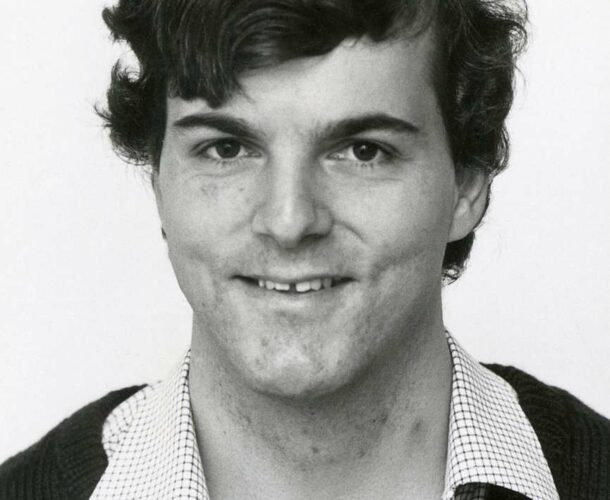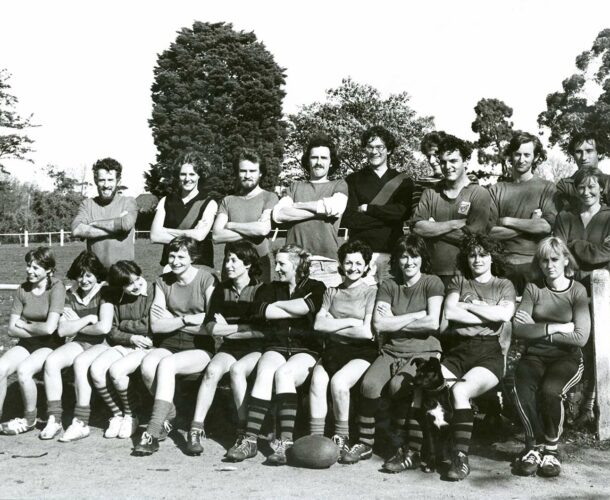Researchers from the Walter and Eliza Hall Institute and Ludwig Institute of Cancer Research produce the first cloned CSF gene. This vital step in producing enough CSFs for preclinical trials to test their effectiveness in stimulating white blood cell production was critical to their final use as a human treatment for cancers and bone marrow transplants.
Molecular biologist Dr Nick Gough is working at the Ludwig Institute with Professors Tony Burgess, Nick Nicola and Ashley Dunn. The challenge for the molecular biologists and protein chemists from both institutes was to clone the CSF genes. It was a bold step and still early days for cloning of mammalian genes.
Efforts by Professor Don Metcalf and his team to purify the elusive CSFs from their only recognised pure source has so far yielded just a few millionths of a gram of the desired product.
As Metcalf later recalled: “We recognised that we could never extract enough native CSF… to get enough material for one patient we would have had to work for 250 years. We had purified CSF, we had done elegant tissue culture experiments, but now we’re into logistics and were facing a big black hole.”
The looming DNA revolution
Gough’s relationship with the Walter and Eliza Hall Institute began in 1975, when he attended a conference. The institute’s superstar couple Professors Suzanne Cory and Jerry Adams were on the podium reporting on their latest, hottest paper.
In 1975 recombinant DNA technology – combining DNA from two or more sources – was just creeping into leading laboratories, and medical research was about to be tipped into a dizzying new era of exploration.
Gough, an honours student in the University of Adelaide’s powerhouse biochemistry department, arrived right on time to imagine a future in the looming genetic engineering revolution.
It was an exciting talk. They (Cory and Adams) were at the top of their game,” Gough recalls. The next year, he became their first PhD student.
They created the first recombinant DNA-enabled molecular biology group in Australia. They had the first certified laboratory, and it was an epicentre for Australian development of this technology. They were connected globally.
Gough today credits the institute’s defining molecular biology grunt to Cory and Adams and the lab team they assembled and nurtured through that era. “Even if they didn’t have a personal hand in lots of the ensuing science, their impact, and that of Gus (Nossal) bringing them to the institute was immense.
“I had a fantastic time there as PhD student. I met my wife (Jill Gough, a laboratory technician – the pair would collaborate for many years) there. It doesn’t get much better – until you get to GM-CSF (colony stimulating factors) cloning a couple of years later.”
After spending 1980-82 at the European Molecular Biology Laboratory, Germany, Gough was recruited by Professor Tony Burgess to join the newly-created research affiliate, the Ludwig Institute of Cancer Research.
And so it was that Gough came to make a defining contribution to what is recognised as one of – if not the – greatest discovery in the institute’s century of science.
Champagne, the DNA sequence and the America’s cup
The Ludwig team was intimately collaborating with Metcalf, then some 15 years of hard slog down the track in his epic 50-year investigation of CSFs, hormone-like substances secreted in miniscule quantities in cells, but with the power to stimulate the growth of blood cells.
Painstakingly, piecing together fragments of sequence data, they managed by September 1983 to fish out a partial clone of GM-CSF from the mouse lung. “That enabled us to identify complete DNA clones that were able to make GM-CSF from a T-cell line (nurtured by Dr Anne Kelso) that was chock-a-block full of GM-CSF.”
It was a high-adrenalin moment. Outside the laboratory, the rest of Australia was in a lather over a yacht race on the other side of the world. “I’m sure I recall a lab meeting where we had champagne – to celebrate the DNA sequence of GM-CSF, and the America’s Cup!”
The elation was about the science – about pushing through a tough bit of science and pulling it off.
The ‘end game’
But there was also by then a growing awareness of what this might mean in the clinic, particularly for cancer patients. “Insulin had come out of a biological phenomenon in the late 1800s, and within weeks of it being purified in the early 1920s it was in the clinic, and was a pharmaceutical within little over a year. So we knew that biological entities could be therapeutics – you just had to make enough of them.
It was not long before tenor Jose Carreras – diagnosed with acute leukaemia and fighting for his life – was amongst the first patients whose survival was credited to treatment with CSFs. That was 1989. Today the CSFs are credited with benefiting more than 20 million cancer patients by boosting their white blood cell counts and thereby helping them survive the rigours of chemotherapy.

